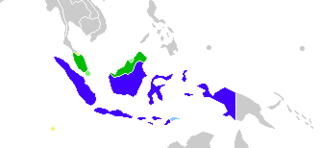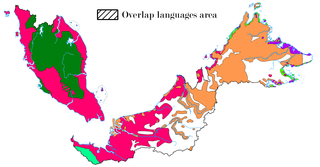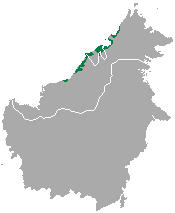Related Research Articles

Malay is an Austronesian language that is an official language of Brunei, Indonesia, Malaysia, and Singapore, and that is also spoken in East Timor and parts of Thailand. Altogether, it is spoken by 290 million people across Maritime Southeast Asia.

The Iban language is spoken by the Iban, one of the Dayak ethnic groups, who live in Brunei, the Indonesian province of West Kalimantan and in the Malaysian state of Sarawak. It belongs to the Malayic subgroup, a Malayo-Polynesian branch of the Austronesian language family.

Dewan Bahasa dan Pustaka, abbreviated DBP, is the government body responsible for coordinating the use of the Malay language and Malay-language literature in Malaysia.

The Kedayan are an ethnic group residing in Brunei, Federal Territory of Labuan, southwest of Sabah, and north of Sarawak on the island of Borneo. According to the Language and Literature Bureau of Brunei, the Kedayan language is spoken by about 30,000 people in Brunei, and it has been claimed that there are a further 46,500 speakers in Sabah and 37,000 in Sarawak. In Sabah, the Kedayan mainly live in the southern districts of Sipitang and Beaufort, where they are counted as a part of the local Malay populace. Whilst in Sarawak, the Kedayans mostly reside in the towns of Lawas, Limbang and Miri.

The Malayic languages are a branch of the Malayo-Polynesian subgroup of the Austronesian language family. The most prominent member is Malay, a pluricentric language given national status in Brunei and Singapore while also the basis for national standards Malaysian in Malaysia and Indonesian in Indonesia. The Malayic branch also includes local languages spoken by ethnic Malays, further several languages spoken by various other ethnic groups of Sumatra, Indonesia and Borneo even as far as Urak Lawoi in the southwestern coast of Thailand.

The Banjar or Banjarese is an Austronesian language predominantly spoken by the Banjarese—an indigenous ethnic group native to Banjar regions— in the southeastern Kalimantan of Indonesia. The Banjarese language is the de facto lingua franca for various indigenous community especially in South Kalimantan, as well as Central Kalimantan and East Kalimantan in general.
Coastal Kadazan, also known as Dusun Tangara, is a dialect of the Central Dusun as well as a minority language primarily spoken in Sabah, Malaysia. It is the primary dialect spoken by the Kadazan people in the west coast of Sabah especially in the districts of Penampang, Papar and Membakut.

The indigenous languages of Malaysia belong to the Mon-Khmer and Malayo-Polynesian families. The national, or official, language is Malay which is the mother tongue of the majority Malay ethnic group. The main ethnic groups within Malaysia are the Malays, Chinese and Tamils, with many other ethnic groups represented in smaller numbers, each with its own languages. The largest native languages spoken in East Malaysia are the Iban, Dusunic, and Kadazan languages. English is widely understood and spoken within the urban areas of the country; the English language is a compulsory subject in primary and secondary education. It is also the main medium of instruction within most private colleges and private universities. English may take precedence over Malay in certain official contexts as provided for by the National Language Act, especially in the states of Sabah and Sarawak, where it may be the official working language. Furthermore, the law of Malaysia is commonly taught and read in English, as the unwritten laws of Malaysia continue to be partially derived from pre-1957 English common law, which is a legacy of past British colonisation of the constituents forming Malaysia. In addition, authoritative versions of constitutional law and statutory law are continuously available in both Malay and English.
Sarawak Malay is a Malayic language native to the State of Sarawak. It is a common language used by natives of Sarawak and also as the important mother tongue for the Sarawakian Malay people.
The Ibanic languages are a branch of the Malayic languages indigenous to western Borneo. They are spoken by the Ibans and related groups in East Malaysia and the Indonesian province of West Kalimantan. Other Dayak languages, called Land Dayak, which are not Ibanic, are found in the northwest corner of Kalimantan, between Ibanic and non-Ibanic Malayic languages such as Kendayan and the Malay dialects of Sarawak and Pontianak.

Lun Bawang or Lundayeh is the language spoken by the Lun Bawangs. It belongs to the Malayo-Polynesian family.
Central Dusun, also known as Bunduliwan, is an Austronesian language and one of the more widespread languages spoken by the Dusun peoples of Sabah, Malaysia.
The Land Dayak languages are a group of dozen or so languages spoken by the Bidayuh Land Dayaks of Borneo, and by some, also spoken by the Rejang people of southwestern Sumatra.

Kelabit is one of the most remote languages of Borneo, on the Sarawak–North Kalimantan border. It is spoken by one of the smallest ethnicities in Borneo, the Kelabit people.

The Brunei Malay language, also called Bruneian Malay language, is the most widely spoken language in Brunei and a lingua franca in some parts of Sarawak and Sabah, such as Labuan, Limbang, Lawas, Sipitang and Papar. Though Standard Malay is promoted as the official national language of Brunei, Brunei Malay is socially dominant and it is currently replacing the minority languages of Brunei, including the Dusun and Tutong languages, existing in a diglossic speech, wherein Brunei Malay is commonly used for daily communication, coexisting with the aforementioned regional languages and Malay creoles, and standard Malay used in formal speech; code switching between standard Malay and Brunei Malay is spoken in informal speech as a lingua franca between Malay creoles and regional languages. It is quite similar to Standard Malay to the point of being almost mutually intelligible with it, being about 84% cognate with standard Malay. Standard Malay is usually spoken with Brunei pronunciation.
The Tutong language, also known as Basa Tutong, is a language spoken by approximately 17,000 people in Brunei. It is the main language of the Tutong people, the majority ethnic group in the Tutong District of Brunei.
Kendayan, or Salako (Selako), is a Malayic Dayak language of Borneo. The exact number of speakers remains unknown, but is estimated to be around 350,000.
Perak Malay is one of the Malay dialects spoken within the state of Perak, Malaysia. Although it is neither the official language nor the standard dialect in the whole state of Perak, its existence which co-exists with other major dialects in the state of Perak still plays an important role in maintaining the identity of Perak. In spite of the fact that there are five main dialects traditionally spoken in Perak, only one of which is intended by the name "Perak Malay". There are subtle phonetic, syntactic and lexical distinctions from other major Malay dialects. Perak Malay can be divided into two sub-dialects, Kuala Kangsar and Perak Tengah, named after the daerah (districts) where they are predominantly spoken.
Pontianak Malay is a Malayan language spoken in Pontianak, Indonesia and the surrounding area.
Mendawai is an Austronesian language spoken along the lower course of the Arut River in West Kotawaringin Regency, Central Kalimantan, Indonesia. It is at the mutually unintelligible end of a dialect continuum with Ngaju. Mendawai and Ngaju share c. 70% of their basic vocabulary.
References
- ↑ Biatah at Ethnologue (18th ed., 2015) (subscription required)
- ↑ Darmansyah, Durdje Durasid; Sari, Nirmala (1994). Morfologi dan sintaksis bahasa Bedayuh. Jakarta: Pusat Pembinaan dan Pengembangan Bahasa, Departemen Pendidikan dan Kebudayaan.
- ↑ Topping (1993)
- Topping, Donald M. A Dialect Survey of the Land Dayaks of Sarawak, Language and Oral Traditions in Borneo. 1993. Selected Papers from the First Extraordinary Conference of The Borneo Research Council, Kuching, Sarawak, Malaysia, August 4–9, 1990, pp. 247–274